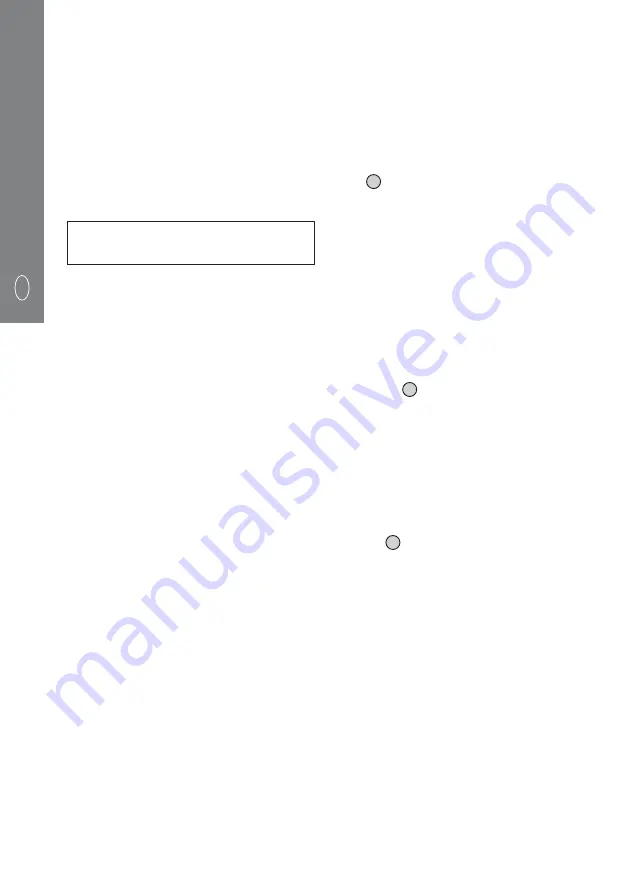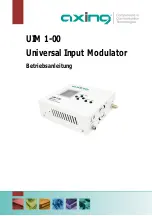
14
UK
■
DESCRIPTION
●
DVB-S and DVB-S2
signal transmodulator in
DVB-T
Free-to-Air (STT 8000) and with Conditionnal Access
DVB-CI (STT-CI 8000). Admits
QPSK or 8PSK
input
signals and modulated signal delivery in COFDM.
Allows satellite programs to be viewed with DTT receivers.
1st IF SAT
signal with digital programming is converted
to the RF band between
50.5 and 858 MHz
modulated
in DVB-T. Handles
MPEG-2 or MPEG-4
signals enabling
selection of programs delivered on output.
■
INSTALLATION AND START-UP
●
Insert the CAM
into the module ( look position N 10
in the CONTROLS schema) before placing the module
on the frame (STT-CI 8000).
●
Connect the
earth connection
of the frame to the earth
connection of the antenna installation.
●
Fix the modules to the frame in the
order
shown in the
application example
(see page 3), with the power source
on the right and the amplifier on the left of the unit.
●
Make the
signal distribution
of the antenna(s) via the F-F
coaxial bridge (Ref. 83814) and
load
the free output(s)
with 75
Ω
(Ref. 84011).
●
Join the
RF channel outputs
(8) via the F-F coaxial bridge,
and
load
the free output of module 1
with 75
Ω
, beside
the power source.
●
Connect the
Supply bus
BA 807 ref. 83807 between the
modules (5) and the SPS.
●
Connect the
antenna drop cables
to the corresponding
inputs (1).
●
Connect the power source to the
mains
.
■
WORKING TEMPERATURE
●
The modules have to be refreshed for their correct
operationt. It's recommended to install the modules in
the housing with fan (Ref 83806) or, when installing on
a 19" rack, to use the Rack ventilation Unit (ref 83801)
When there are few modules to install, it's possible to
use the fan VNT 800 on the wall frame (fig N 1).
■
MODULES PROGRAMMATION
The modules can be programmed:
●
Through the UCF 300 Control Unit (Ref 85115) in local
mode, following the steps explained in this manual.
●
Through a PC in local mode. In this case, it's necessary
to have a MCU 8000 unit and the "8000 series" interface
installed in the PC.
■
UCF 300: FUNCIONES DE LAS TECLAS
●
The buttons
❏
▲
❏
▼
are for vertical menu scrolling.
a) On the
programming menu
they are for selecting the
function
to be programmed.
b) A
parameter can be selected
within a
function
.
c) A
parameter setting
can be modified within a
programmable parameter
.
●
The
buttons are for horizontal scrolling through the
programming menu, e.g.:
Function parameter value.
●
The button is for moving right.
●
The button is for exiting without changing the setting:
escape.
●
The button is for validating the data item programmed.
■
DISPLAY INDICATIONS
●
The
UCF 300
control unit has
two rows of alphanumerical
characters. The data display mode and
programming
diagram
on page 8 are a guide to this process:
●
If the characters are
all upper case and on the upper
row
, this indicates that one of the
5 functions
has been
entered.
●
If
data appear on two rows
of the display, the
parameter to be adjusted
is being displayed.
●
The
right arrow
shows how to enter to
change the
parameter setting
.
●
A
flashing box
indicates that the
parameter setting can
be modified
using the
❏
▲
❏
▼
(press the button to validate).
●
A
“+” sign
followed by the name of the service indicates
that this
service
is in the
output multiplex
.
●
A
“ * ” sign
before the name indicates an
encrypted
service
.
■
PROGRAMMING with UCF 300
●
Connect the UCF 300 to the desired module. After a
few seconds, the unit will show the model in question:
STT 8000.
●
Press the button to enter the standard menu
(press 3 sec to go to the extended menu):
1. RF OUTPUT
2. DVB-T OUTPUT (extended menu)
3. SAT INPUT
4. OUTPUT SERVICES
5. PSI EDIT (extended menu)
6. CAM (extended menu) / (STT-CI 8000)
7. MEMORY
●
Press the
❏
▲
❏
▼
button to scroll through the
functions
.
●
Press the button to enter the parameters of the
desired
function
.
See
programming diagram
on page 8.
1. RF OUTPUT: RF output
1.1. Out Frequency:
50,5 ÷ 858 MHz.
1.2. Out Level:
65 ÷ 80 dB
μ
V
.
1.3. Out RF:
Enables/disables the RF output.
- The power sources must be disconnected from
the mains before connecting or disconnecting the
module.
OK
OK
OK
❏
▼
❏
▼
❏
▼
❏
▲
❏
▼
❏
▲
❏
▼
❏
▲
❏
▼
❏
▲
Summary of Contents for SCT 8000
Page 13: ...13 ...










































